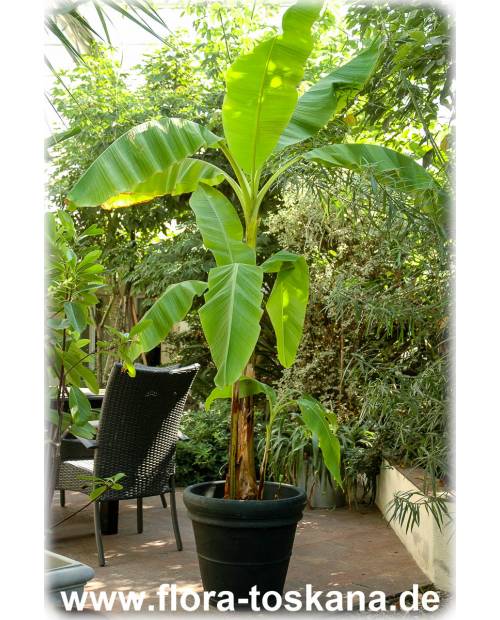







































































BESTSELLER (rank 11) - Banana plants in our gardens – that's not possible?! But it is, because the roots of the Japanese Fiber Banana (Musa basjoo) survive with simple winter protection in the ground and grow new and more shoots every year with lance-shaped, light green leaves – a tropical decoration for your (front) garden.
Banana plants permanently in German gardens – impossible?! However, with the Japanese Fiber Banana (Musa basjoo) it is possible. This plant is not native to the tropics, but to the Japanese island of Ryukyu, where snow and cold in winter are quite familiar. If you want to plant the Japanese Fiber Banana into the garden instead of keeping it in pots (which works fine as well!) you should do so in spring, when the soil has dried off a bit from the winter wetness and warmed up. A well-drained, loose and at the same time nutrient-rich soil is of great importance. That is, it should contain a lot of humus and only a little clay, and be improved with gravel or sand. Partial shade with high humidity is ideal for this plant. If placed in a sunny place, the Japanese Fiber Banana requires a permanently moist soil. Places sheltered from the wind are ideal, as the leaves tear less often and severely here. Rooted specimens can reach 2-3.5 m in height in just one summer. Over the years, new saplings will grow from the roots and form an imposing thicket or even a little 'banana forest'. For this reason, they are often planted as a 'tropical island in the lawn'.
In the fall, the leaves begin to turn yellow and fade when the temperature goes down. Just before the permafrost sets in, cut off the leaves and cut the trunk at a height of about 50-80 cm. The trunk (pseudostem) will become mushy during the winter. If you cap the trunk just above the ground, rot could penetrate the roots too easily. Drive four poles into the ground around the plant, around which chicken wire is stretched. Loosely (!) fill this "cage" with 80 cm of dry leaves and cover with perforated foil or bast mats. Leave the sides open to ensure adequate ventilation and drying. Complete wrapping in foil would cause the plant to rot. There is a lot of information about the frost hardiness of protected bananas worldwide. In the USA, Musa basjoo is classified in climate zone 5 to 6, or zone 8 if unprotected. However, since winter consists not only of cold, but also of moisture, temperature changes due to the sun, and much more, we think that a classification in zone 7 is a good benchmark for Central and Northern Europe.
In the spring near the end of the frost period, remove winter protection and spread mature compost soil around the plants for fertilization. Japanese Fiber Bananas then quickly grow new shoots from the base that will form a tropical eye-catcher in any garden – as well as in containers decorating your patio/balcony from spring to fall or your winter garden all year round.
![]() Quality: hardy banana for planting into the garden, exotic tropical look with large banana leaves; robust and easy to care for
Quality: hardy banana for planting into the garden, exotic tropical look with large banana leaves; robust and easy to care for![]() Use: planted permanently into the garden (with winter protection); in pots starting from April/May outside on balcony/terrace/patio; all year round in a conservatory
Use: planted permanently into the garden (with winter protection); in pots starting from April/May outside on balcony/terrace/patio; all year round in a conservatory
Data sheet
You might also like
Customers who bought this product also bought: